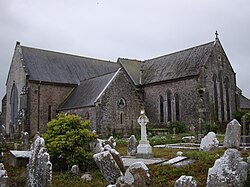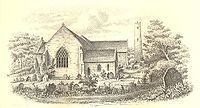Cloyne Cathedral
| St Colman's Cathedral, Cloyne | |
|
County Cork | |
|---|---|
| Status: | Cathedral |

| |
| Church of Ireland | |
| Diocese of Cork, Cloyne and Ross | |
| Location | |
| Grid reference: | W91826769 |
| Location: | 51°51’42"N, 8°7’10"W |
| History | |
| Information | |
| Website: | cork.anglican.org |
The Cathedral Church of St Colman, Cloyne, commonly known as St Colman's Cathedral or Cloyne Cathedral is one of the cathedrals of the Diocese of Cork, Cloyne and Ross in the Church of Ireland. It stands in Cloyne, County Cork.
The Cathedral was built to serve the Diocese of Cloyne: after the merging of dioceses however it falls under the united Diocese of Cork, Cloyne and Ross, which has three cathedrals: Cloyne, Cork and Ross.
Across the road from the cathedral stands Cloyne Round Tower, which has been used as the tower for the cathedral bell.
History

Early history
The cathedral traces its origins to a monastic settlement founded in 560 by Colmán of Cloyne. The site for his monastery and monastic school at Cloyne (Cluain Uamha or 'Meadow of the Caves') was donated by Coirpre Cromm mac Crimthainn, King of Munster. The monastery was plundered by the vikings in 822, 824 and 885. In the 885 raid, the abbot, prior, and several others were killed, and Cloyne is not mentioned in the monastic annals again until 1060.[1] Bishop Nehemias of Cloyne is noted as having died in 1149,[1] shortly beforeCloyne was recognised as a diocese at the Synod of Kells in 1152.
A series of churches were built on the site, with the present building dating from 1250.[2] A building on the grounds of the Cathedral, known as the "Fire House", may once have been an oratory, or alternatively may have been used by a female order to keep a fire continuously burning.[3]
17th century
During the 1641 Rebellion, the church was damaged. It was repaired in 1642.[3] Considerable work was also carried out on the choir of the church in the 17th century.[4] In 1675, a girl named Mary Smyth died and was buried beneath the floor of the nave. Her burial place is marked with a horseshoe (the symbol of the farrier, or smith) carved into the ground. Known as the ""devil's footprint", local superstition claims that this is a footprint left by Satan. [5]
18th century
In 1705, repairs were carried out on the chapter house and the choir was enlarged.[3] In an effort to make the cathedral look "more Gothic", works were carried out on the cathedral throughout the 18th and 19th centuries.[4] In either 1705,[1] or 1706, the cathedral was reroofed, and the battlements in the walls of the nave were removed.[3] In 1733 the new roof underwent restoration.[6] In 1774, the "Great Arch" was removed from the entrance to the choir.[3][7] In 1776, the cross wall in the choir was removed. During these works, a row of graves were found beneath the foundation of the church. The graves consisted of "brick coffins", matching the shapes of the corpses within them.[7]
On Shrove Tuesday 1781, a "violent hurricane" severely damaged the cathedral. The north side of the churchyard wall was blown over, and 88 panes of glass in the cathedral was shattered. It took a team of slaters 11 days to repair the damage done to the roof, using 1,200 slates in the process.
19th century - present
In 1856 new windows were added to the choir, an area of the church that went under substantial renovation in the 1890s.[3] Theses renovations included a new ceiling, new choir stalls, the removal of the gallery on the western wall, and the relocation of the organ.[3]
The church served as the cathedra of the bishopric of Cloyne until 1835, when it was united with the Diocese of Cork.[8]
(A Roman Catholic cathedral of St Colman was built at Queenstown beginning in 1868 and completed in the early years of the 20th century.)
In 1911, renovations were carried out to plans by Arthur Hill, the costs of which were covered by an anonymous donor from India.[9]
Architecture
The original 13th-century cruciform development remains the core of the cathedral today.[10] Some sources suggest that there was once a tower at the intersection of the transepts,[3] while others say that while older sources mention a tower being there, there is no evidence to support such a claim.[11][12]
Arched windows in the south transept of the cathedral are an example of Early English Gothic architecture.[13] Other windows in the cathedral are in the Decorated Gothic style.[14] In 1837 Samuel Lewis described the building as being built "in the later English style of architecture".[15] The cathedral features several stained glass windows including one depicting Saint Colmán.[16]
Cloyne Round Tower
- Main article: Cloyne Round Tower
Cloyne Round Tower was constructed in either the tenth or eleventh century, and was used as a bell tower by the monks. It was again used as a bell tower from 1683.[17] In 1749 it was struck by lightning.[3]
References
- ↑ 1.0 1.1 1.2 Galloway 1992, p. 52.
- ↑ Day, J.G.F. and Patton, H.E.: 'The Cathedrals of the Church of Ireland' (SPCK, 1932) page 139
- ↑ 3.0 3.1 3.2 3.3 3.4 3.5 3.6 3.7 3.8 St Leger 2013, p. 370.
- ↑ 4.0 4.1 Hallinan 2013, p. 75.
- ↑ Barker 1977, p. 50.
- ↑ Ó Loinsigh 1977, p. 56.
- ↑ 7.0 7.1 Ó Loinsigh 1977, p. 58.
- ↑ Hallinan 2013, p. 73.
- ↑ Hill, Arthur: Dictionary of Irish Architects
- ↑ Hallinan 2013, p. 74.
- ↑ Galloway 1992, p. 54.
- ↑ Fallow 1894, p. 42-43.
- ↑ Hallinan 2015, p. 18.
- ↑ Hallinan 2015, p. 19.
- ↑ Lewis 1837, p. 382.
- ↑ "Cloyne Cathedral St Colman". 15 May 2008. https://www.gloine.ie/search/window/15305/W03.
- ↑ Lewis 1837, p. 383.
- Barker, Rev. J.K.S. Ridley (1977). "Cloyne Cathedral". in Ó Loinsigh, Pádraig. The Book of Cloyne. Cloyne. pp. 49–54.
- Fallow, T.M. (1894). The Cathedral Churches of Ireland. Old bailey: Bemrose & Sons. pp. 42–46. ISBN 9781166944124.
- Galloway, Peter (1992). The Cathedrals of Ireland. Belfast: Queen's University Belfast. pp. 52–54. ISBN 0-85389-452-3.
- Hallinan, Mona, ed (2015). Heritage Churches of County Cork. Cork: Heritage Department of Cork County Council. pp. 18–19; 72–75. ISBN 978-0-9525869-2-0. https://www.corkcoco.ie/sites/default/files/2017-04/Heritage%20Churches.pdf.
- Lewis, Samuel (1837). A Topographical Dictionary of Ireland. 1. London: Lewis & Co.. pp. 381–383. https://books.google.com/books?id=ZAA2AQAAMAAJ&q=topographical+dictionary+of+ireland.
- Ó Loinsigh, Pádraig (1977). "Cloyne Cathedral through the Ages". in Ó Loinsigh, Pádraig. The Book of Cloyne. Cloyne. pp. 55–59.
- St Leger, Dr. Alicia (2013). "The Province of Dublin: Cork, Cloyne and Ross". in McAuley, Alicia. The Church of Ireland: An illustrated history. Dublin: Booklink. pp. 369–370. ISBN 978-1-906886-56-1.
| Cathedrals of the Church of Ireland |
|---|
|
Province of Armagh:
Armagh •
Clogher •
Derry •
Downpatrick •
Dromore •
Elphin •
Enniskillen •
Killala •
Kilmore •
Lisburn •
Raphoe •
Sligo •
Tuam •
Belfast
|